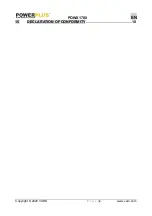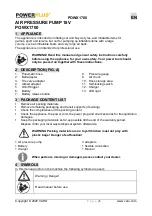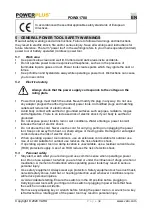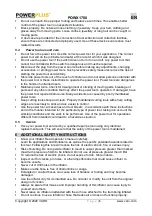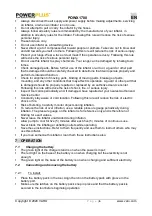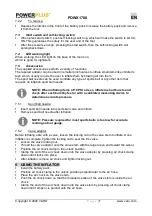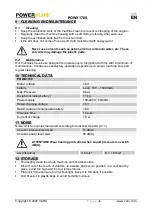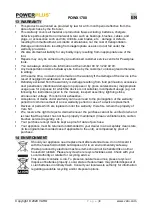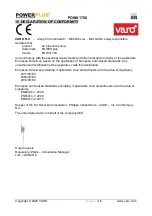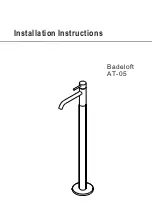
POWX1700
EN
Copyright © 2020 VARO
P a g e
|
5
www.varo.com
▪
Do not overreach. Keep proper footing and balance at all times. This enables better
control of the power tool in unexpected situations.
▪
Dress properly. Do not wear loose clothing or jewellery. Keep your hair, clothing and
gloves away from moving parts. Loose clothes, jewellery or long hair can be caught in
moving parts.
▪
If devices are provided for the connection of dust extraction and collection facilities,
ensure these are connected and properly used. Use of these devices can reduce dust
related hazards.
5.4
Power tool use and care
▪
Do not force the power tool. Use the correct power tool for your application. The correct
power tool will do the job better and safer at the rate for which it was designed.
▪
Do not use the power tool if the switch does not turn it on and off. Any power tool that
cannot be controlled with the switch is dangerous and must be repaired.
▪
Disconnect the plug from the power source before making any adjustments, changing
accessories, or storing power tools. Such preventive safety measures reduce the risk of
starting the power tool accidentally.
▪
Store idle power tools out of the reach of children and do not allow persons unfamiliar with
the power tool or these instructions to operate the power tool. Power tools are dangerous
in the hands of untrained users.
▪
Maintain power tools. Check for misalignment or sticking of moving parts, breakage of
parts and any other condition that may affect the power tool’s operation. If damaged, have
the power tool repaired before use. Many accidents are caused by poorly maintained
power tools.
▪
Keep cutting tools sharp and clean. Properly maintained cutting tools with sharp cutting
edges are less likely to stick and are easier to control.
▪
Use the power tool, accessories and tool bits etc., in accordance with these instructions
and in the manner intended for the particular type of power tool, taking into account the
working conditions and the work to be performed. Use of the power tool for operations
different from intended could lead to a hazardous situation.
5.5
Service
▪
Have your power tool serviced by a qualified repair person using only identical
replacement parts. This will ensure that the safety of the power tool is maintained.
6 ADDITIONAL SAFETY INSTRUCTIONS
▪
Know your inflator. Read operator’s manual carefully.
▪
Learn its applications and limitations, as well as the specific potential hazards related to
this tool. Following this rule will reduce the risk of electric shock, fire, or serious injury.
▪
Risk of bursting. Do not operate inflator to result in output pressure greater than marked
maximum pressure of item to be inflated. Do not use at pressure greater than 8 Bar.
▪
To reduce the risk of electric shock, do not expose to rain. Store indoors.
▪
Inspect unit for cracks, pin holes, or other imperfections that could cause inflator to
become unsafe.
▪
Never cut or drill holes in the inflator.
▪
Make sure the hose is free of obstructions or snags.
▪
Entangled or snarled hoses can cause loss of balance or footing and may become
damaged.
▪
Use the inflator only for its intended use. Do not alter or modify the unit from the original
design or function.
▪
Always be aware that misuse and improper handling of this inflator can cause injury to
yourself and others.
▪
Never leave an inflator unattended with the air hose attached to the item being inflated.
▪
Do not continue to use a inflator or hose that leaks air or does not function properly.


